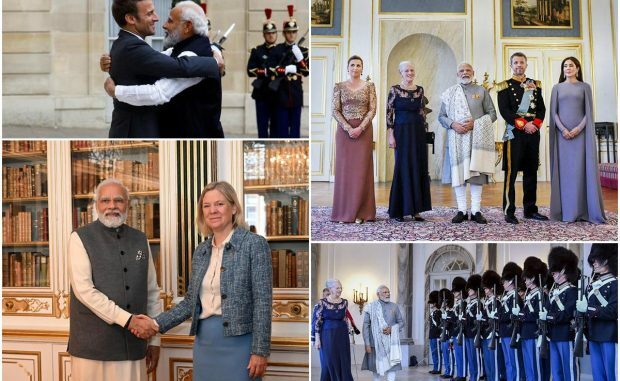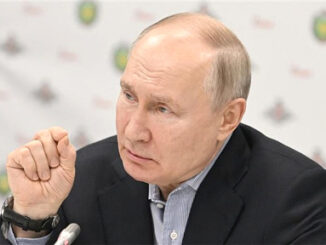

3 days, 3 countries and meetings with 7 heads of government– PM Narendra Modi certainly packed some pace in his tour of Europe- but did the meetings lack punch? We are going to tell you about the agreements and the areas of disagreement during his visits to Germany, France, and Denmark. Remember, the visit also took place just after European Commission President Ursula Von Der Leyen visited Delhi last week for the Raisina Dialogue and held talks with the PM.
PM’s visits to each of the three European capitals had a specific focus:
1 In Berlin PM was meeting new German Chancellor Olaf Scholz for the biennial Inter Governmental Commission talks between the two countries
2 In Denmark, he attended the Second Nordic Summit with leaders of Denmark, Finland, Iceland, Norway and Sweden
3 In France, he was meeting newly re-elected President Emmanuel Macron, with the old bonhomie between the two leaders quite visible This was the PM’s first visit abroad this year after a number of high level meetings were cancelled due to the Omicron virus outbreak. It is also his first visit to Europe since the big war in Ukraine, which has changed Europe’s entire course, began. I will come to that shortly, but broadly, the outcomes of all three visits were seen in these areas:
1 Green partnership: India’s partnerships with the EU have always had a strong emphasis on countering climate change.
– In Germany, Chancellor Scholz announced an advance commitment of 10 Billion Euros for a green partnership. They also agreed to a 7 point agenda on Renewable energy and Sustainable growth cooperation and decided to set up a biennial Ministerial mechanism to lead these initiatives.
– In Denmark, the PM spoke to each of his Nordic counterparts about boosting cooperation in the wind and solar energy, pollution control and urban renewal projects and other green projects. PM also repeated commitments made at COP26- 500 gigawatts of non-fossil fuel by 2030, 50% of energy capacity to come from renewable energy by 2030, reduction of 1 billion tons in projected carbon emissions by 2030, the carbon intensity of India’s economy to reduce by 45% by 2030 and net zero by 2070. However, 6 months later these remain verbal commitments, as India has not yet updated its Nationally Determined Commitments (NDCs)- awaiting climate finance.
– And in France, PM Modi called for French investment in making India a Green hydrogen hub, while both countries agreed to an integrated approach on supply chains for solar energy production in Europe and Asia. In addition, a statement from French power group EDF after the visit said it hopes to make progress on the long pending deal for six nuclear power reactors at Jaitapur.
2 Defense and Security partnerships:
– With Germany, India agreed to step up high-tech transfer collaborations, and signed a joint declaration of intent for an agreement on exchange of classified information
– The Nordic stop did not have a security component but focused on new technologies
– In France, the two sides set up a strategic dialogue on Space issues, strengthen a cyber dialogue and find more ways for France to invest in building India’s defense industry
3 Finally, India and the EU have now begun to discuss cooperation in the Indo-Pacific. What is also significant is a sort of triangular engagement with Japan just in the past few weeks. German Chancellor Scholz was in Japan just before PM Modi’s visit to Germany. The next EU Japan summit will be held in Tokyo next week. PM Kishida was in Italy, followed by the Italian FM visit to Delhi. And PM Modi will travel to Japan later this month for the Quad summit.
While these were all areas of discussion, the PM’s Europe tour was marked by some disagreements too:
1 To begin with, while there were several joint statements and joint declarations of intent, there were very few actual agreements signed during the visit.
2 Disagreement on Ukraine: This has been a recurring theme over the last few weeks, whether it was in the US, or with European leaders in Delhi, or during the PM’s visit to Europe, India’s position on Ukraine and Russia remains a far distance from the West’s position, and this was reiterated during this week’s stops.
The differences will possibly come up again next month- as Germany has Invited India to the G7 summit in June, PM Modi has not yet confirmed his attendance.
3 Energy from Russia: This is going to be an area of greater divergence in the future, as the EU has begun a new round of negotiations aimed at cancelling Russian oil imports by bringing forward a cut off date for European countries to the end of 2022.
India has not only refused to join EU sanctions, but it has also accelerated its oil imports from Russia- According to a Reuters report based on collating information from crude oil importers and traders- India has ordered at least 40 million barrels of Russian oil between February 24-April 24 meaning that – India has taken in two months more than double what it did all of last year- 16 million barrels
4 India EU FTA: When PM Modi visited Berlin last for the Inter-Governmental Commission in 2018, he and then Chancellor Merkel had committed to restarting talks between India and the European Union for a Bilateral Trade and Investment Agreement or FTA, that have been suspended since 2013. Despite dozens of similar promises, the talks have yet to restart. As India has fast tracked other FTAs with UAE, Australia, UK and others, many had thought they would see movement on the India EU FTA as well, but apart from a stray mention during the visit to Denmark, the talks between trade negotiators didn’t get much fillip during the visit. The EU is India’s 3 largest trading partner, after China and US, and its 2 largest export destination, but its potential is far more, which an FTA might help in achieving.
5 Human Rights and Press Freedom in India– Like the US meetings last month, the European countries, which conduct their foreign policy through the EU have also expressed concerns about human rights violations allegations in India, and a decline in press freedom- the difference is the EU made its statement prior to the PM’s visit- as European Union Special Representative of Human Rights Eamon Gilmore was in Delhi for the Raisina Dialogue. In separate tweets about his meetings with the NHRC and Minority Affairs Minister Naqvi, Mr. Gilmore said he had discussed many specific issues including “the use of FCRA laws to ban funding for NGOs, use of sedition and anti-terrorism laws, detentions, the situation of minorities, communal violence, situation in Jammu Kashmir, and individual cases.”
(The author is an editor with The Hindu)





Be the first to comment